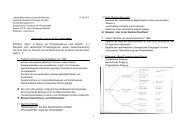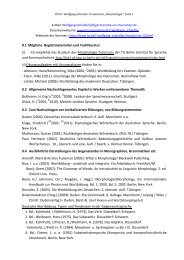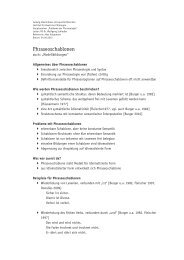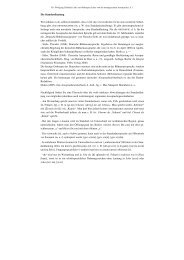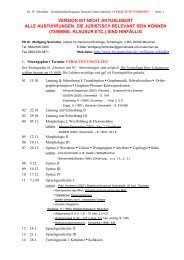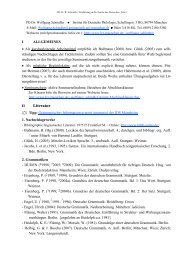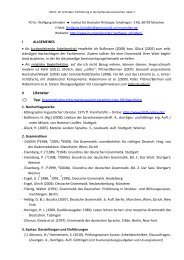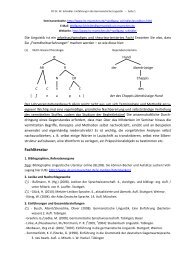Chapter 18 Lexical Functions: Description of Lexical Relations in a ...
Chapter 18 Lexical Functions: Description of Lexical Relations in a ...
Chapter 18 Lexical Functions: Description of Lexical Relations in a ...
Create successful ePaper yourself
Turn your PDF publications into a flip-book with our unique Google optimized e-Paper software.
—<strong>Chapter</strong> <strong>18</strong>. <strong>Lexical</strong> <strong>Functions</strong>— 40<br />
Syntactically, both are nouns; S<strong>in</strong>g takes its L (when it does not replace it) as its DSyntA II, and<br />
Mult takes its L as DSyntA I: S<strong>in</strong>g-II→L, Mult-I→L. 13 L also is a noun, denot<strong>in</strong>g a collectivity/a<br />
set/a substance/a state (<strong>in</strong> case <strong>of</strong> S<strong>in</strong>g) or an object/a person/an event (<strong>in</strong> case <strong>of</strong> Mult).<br />
In some languages, the mean<strong>in</strong>gs <strong>of</strong> S<strong>in</strong>g and Mult are expressible via morphological<br />
elements—grammemes/derivatemes—<strong>of</strong> s<strong>in</strong>gulative and collective.<br />
19. S<strong>in</strong>g [Lat. s<strong>in</strong>gulus (s<strong>in</strong>gular, unique)] = s<strong>in</strong>gulative<br />
L´ which is a S<strong>in</strong>g(L) means (one <strong>in</strong>stance/one unit <strong>of</strong> L); it designates, so to speak, a<br />
‘quantum’ <strong>of</strong> (L).<br />
Examples<br />
S<strong>in</strong>g(fleet) ≈ //ship<br />
S<strong>in</strong>g(sand) = gra<strong>in</strong> [<strong>of</strong> ~]<br />
S<strong>in</strong>g(thunderN) = [~]clap [= thunderclap]<br />
20. Mult [Lat. multum (multitude)] = collective<br />
together.<br />
Examples<br />
S<strong>in</strong>g(air force) ≈ //military aircraft<br />
S<strong>in</strong>g(anger) = fit, gust [<strong>of</strong> ~]<br />
S<strong>in</strong>g(automatic fire) = burst [<strong>of</strong> ~]<br />
L´ which is a Mult(L) means (an aggregate/a set <strong>of</strong> Ls); it designates several Ls taken<br />
Mult(ship) ≈ //fleet<br />
Mult(military aircraft) ≈ //air force<br />
Mult(criticism) = barrage, chorus [<strong>of</strong> ~s]<br />
Mult(wolf) = pack [<strong>of</strong> ~s]<br />
Mult(lie) = pack [<strong>of</strong> ~s]<br />
Mult(lion) = pride [<strong>of</strong> ~s]<br />
LFs 21 and 22 designate two elements important <strong>in</strong> the structure <strong>of</strong> an organization or a<br />
team denoted by L—respectively, the ‘boss’ and the ‘personnel.’ These LFs have a rather narrow<br />
sphere <strong>of</strong> application: their Ls can be only nouns that denote th<strong>in</strong>gs hav<strong>in</strong>g a ‘boss’ and a ‘person-<br />
nel.’ Both LFs are nouns and take L as their DSyntA II: Cap−II→L and Equip−II→L.<br />
21. Cap [Lat. caput (head)] = (the head <strong>of</strong> …)<br />
Examples<br />
Cap(university) = president [<strong>of</strong> ART ~];<br />
rector [<strong>of</strong> ART ~]<br />
Cap(tribe) = chief [<strong>of</strong> ART ~]<br />
Cap(aircraft) = //capta<strong>in</strong><br />
Cap(department [at a university]) = head, chairman,<br />
chair [<strong>of</strong> ART ~]<br />
Cap(empire) = //emperor<br />
Cap(catholic church) = //pope


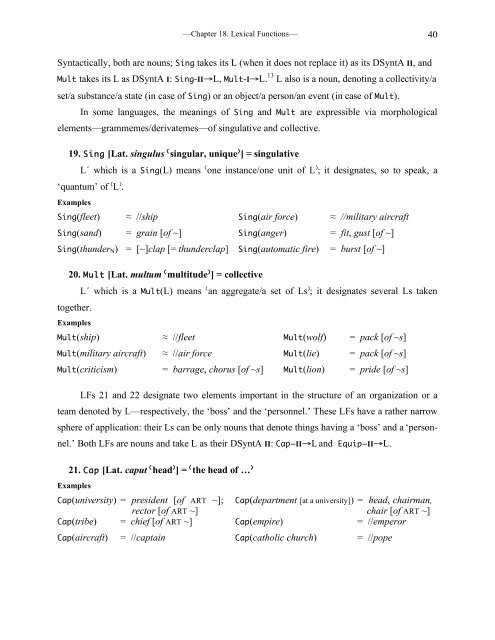
![E-Mail: Wolfgang.Schindler[ätt]germanistik.uni-muenchen.de Web ...](https://img.yumpu.com/51590147/1/184x260/e-mail-wolfgangschindlerattgermanistikuni-muenchende-web-.jpg?quality=85)
